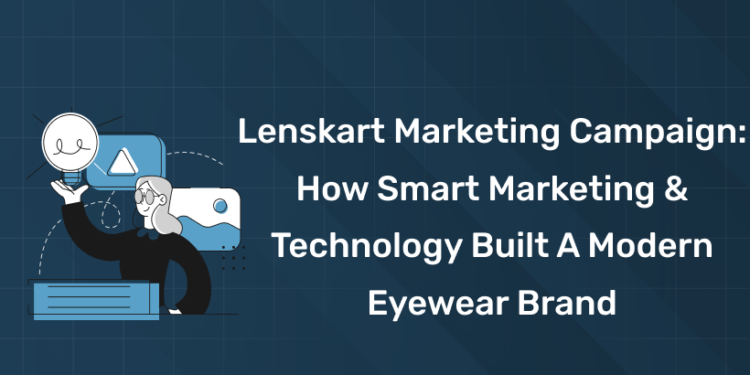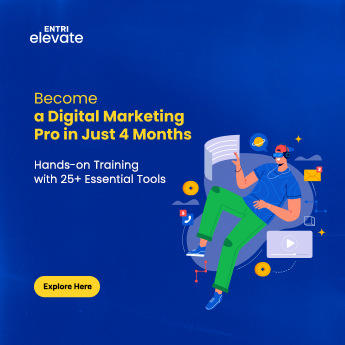Table of Contents
Introduction
In the crowded eyewear retail space, Lenskart didn’t just aim to sell glasses, it set out to reinvent the category. What started as an online-only direct-to-consumer (D2C) eyewear brand quickly evolved into an omnichannel powerhouse thanks to a combination of performance marketing, technology, consumer-centric storytelling, and an ability to scale at pace.
For digital marketing students and professionals, Lenskart offers a living case study of how to blend data-driven campaigns, creative content, and emerging tech to drive growth, engagement, and brand dominance. This blog dives into how Lenskart built its marketing engine, the campaigns that defined its success, the tech scaffolding behind it, and what you, as a marketer or marketing aspirant, can learn. We’ll also show how up-skilling via the Entri AI-Powered Digital Marketing Course can help you replicate this kind of success in your career.
Meeting the business challenge
1: What is the primary goal of SEO (Search Engine Optimization)?
Before the campaigns, Lenskart’s business faced several core challenges:
- Eyewear was seen more as a necessity (to correct vision) rather than as a fashion accessory. Marketing needed to shift perception.
- Online trust was low: buying glasses without trying them on was a risk for customers.
- The market was fragmented, with many local stores, inconsistent quality, and weak online ergonomics.
- Rapid scaling required marketing spend to directly translate into measurable customer acquisition and lifetime value.
Thus, the marketing objective was three-fold: acquire, engage, convert, with a premium on measurable outcomes.
Join Our Online Digital Marketing Course & Learn the Fundamentals!
Become an AI-powered Digital Marketing Expert
Master AI-Driven Digital Marketing: Learn Core Skills and Tools to Lead the Industry!
Explore CourseThe marketing strategy pillars
Lenskart’s success rested on three key pillars:
a. Performance marketing & data-driven targeting
Lenskart tapped digital channels (Google Ads, Facebook, Instagram, YouTube) to reach specific segments:
- Behavioural segmentation (past browsing history, purchase intent).
- Lookalike audiences based on high-value customers.
- Retargeting carts, dynamic product ads to recover abandoned sessions.
By continuously A/B testing creatives, offers and segments, Lenskart improved click-through and conversion rates quickly. The brand blurred the line between “marketing cost” and “growth investment”.
b. Technology & omnichannel experience
What differentiated Lenskart was the marriage of marketing with tech:
- Virtual Try-On using AR/3D technology, letting users try frames virtually on mobile.
- AI-driven recommendation engines, automated segmentation & personalized communication.
- Seamless integration of offline stores and online experience (store visit triggers, geofencing, app drives).
These tech enablers helped lower friction, build trust and justify marketing spend by improving conversion and repeat rates.
c. Creative content, celebrity & culture-led campaigns
Lenskart didn’t rely solely on performance ads. It launched high-impact creative campaigns that built brand recall and helped reframe eyewear as a fashion + lifestyle product:
- “The War of Fair Prices” campaign with Bollywood filmmaker Karan Johar and Lenskart’s CEO. Humour + pricing transparency.
- IPL-themed “Nazar Ghati, Durghatna Ghati 2.0” campaign leveraging the cricket season to embed Lenskart into popular culture.
- Influencer-led content (e.g., Bhuvan Bam) and user-generated content (#MyLenskartLook) to drive authenticity.
This combination of tactical performance campaigns and brand-building creative content is a blueprint for modern digital marketing.
Key campaigns & their impact
Let’s zoom in on a few campaigns and what they achieved:
i. The War of Fair Prices
Objective: Position Lenskart as an affordable, high-quality eyewear.
Execution: Karan Johar vs Peyush Bansal in a humorous battle, emphasising “quality without premium price”.
Impact: Strong brand recall, increased traffic to price-related landing pages (need-data), elevated perception among fashion-conscious young adults.
ii. Nazar Ghati, Durghatna Ghati 2.0 (IPL Campaign)
Objective: Leverage India’s most watched sporting event to increase reach and drive AR tools adoption.
Execution: Use cricket anecdotes to highlight the perils of poor vision + promote virtual try-on tool.
Impact: AR feature usage reportedly grew 3X in two weeks post-campaign.
iii. Technology-first campaigns (Virtual Try-On & AI)
Objective: Lower online purchase friction, reduce returns, and build differentiator.
Execution: Campaigns around “Try-on at home”, digital eye check-up, AI face-scan tech.
Impact: Higher engagement, improved conversion, lower return rates.
Results and business outcomes
What did these efforts translate into?
- The brand value of Lenskart reportedly crossed ₹37,000+ crore by 2025.
- Improved website and app visits, strong social following, and high engagement rates.
- High usage of AR/try-on tools, aiding online growth and reducing reliance on physical stores.
- Enhanced omnichannel footprint: Over 2,000 stores and a strong online presence.
For digital marketers, this shows that marketing isn’t just about spending, it’s about embedding growth loop mechanics (acquisition → experience → retention) via campaigns + tech.
Become an AI-powered Digital Marketing Expert
Master AI-Driven Digital Marketing: Learn Core Skills and Tools to Lead the Industry!
Explore CourseWhy this matters for digital marketing students & professionals
Here are actionable marketing lessons you can apply:
Lesson 1: Align marketing with the business model
Lenskart didn’t just run ads; marketing supported its tech-first, customer-friendly model (virtual try-on, affordable pricing). Strong product + strong marketing = growth.
Lesson 2: Measure performance relentlessly
Performance marketing means tracking clicks, conversions, cost per acquisition (CPA), return on ad spend (ROAS). Lenskart’s use of data platforms (CleverTap) is a key example.
Lesson 3: Blend brand and performance
High-impact campaigns (like Bollywood, cricket) built brand awareness, and performance ads drove acquisition. Both matter.
Lesson 4: Use tech to amplify marketing
AR/AI features aren’t just novelty, they solve customer pain-points, reduce friction and therefore make marketing more efficient.
Lesson 5: Continuous testing and optimization
From A/B testing creatives to dynamic retargeting, digital marketing at scale demands iteration and optimisation, as Lenskart demonstrates.
How the Entri Digital Marketing Course can help you
If you want to replicate or understand campaigns like Lenskart’s, structured learning is key. The Entri AI-Powered Digital Marketing Course covers:
- Performance marketing metrics and channel strategy (Google Ads, Meta, YouTube)
- Campaign creative frameworks mirroring influencer + brand + performance mix
- Technology integration in marketing (AR, AI, data segmentation)
- Omnichannel strategy and full-funnel thinking
- Hands-on labs: designing retargeting flows, influencer campaigns, UGC strategies
By aligning your learning with real-world examples like Lenskart, you move from theory to application, making you usable in the modern digital marketing job market.
Potential challenges and what didn’t work
No strategy is flawless. Some learnings from Lenskart’s journey:
- Performance-only focus may neglect long-term brand value.
- Tech and innovation need to map to actual customer utility; over-promising can harm brand trust.
- Offline and online integration must be seamless; glitches in store experience can undermine digital marketing gains.
- High growth also invites competition, margin pressures, and brand-maintenance costs.
Marketing students should remember: scaling fast is great, but staying sustainable is harder.
Key takeaways for your marketing playbook
- Make product and experience marketing-ready (try-on tech, seamless UX).
- Use data to segment, target and retarget; marketing must be intelligent.
- Combine brand campaigns + performance ads for both reach and results.
- Tech enables marketing, but marketing makes tech matter (AR + campaign = engagement).
- Learn attribution, metrics and optimisation, measurable marketing wins.
- Upskill via courses that integrate these elements end-to-end.
Conclusion
The marketing story of Lenskart is not just about “selling glasses”; it’s an illustration of how modern digital marketing works: driven by data, powered by technology, anchored in story, scaled via performance, and sustained through brand building and experience.
For digital marketing students or working professionals looking to elevate their skill set, this means moving beyond textbook theory. It means understanding channel mechanics, tech integration, campaign optimisation, and brand narrative. The Entri AI-Powered Digital Marketing Course provides that bridge.
Frequently Asked Questions
What is Lenskart’s marketing strategy?
Lenskart’s marketing strategy blends performance marketing, AI-driven targeting, influencer campaigns, and omnichannel experiences to maximise reach and conversions.
How does Lenskart use performance marketing?
The brand uses Google Ads, Meta Ads, and retargeting campaigns to reach high-intent customers and drive measurable sales, optimising cost per acquisition (CPA).
What makes Lenskart’s marketing approach unique?
Lenskart’s integration of technology, like AR-based virtual try-ons and AI recommendations, makes it stand out from traditional retail-driven brands.
Which are Lenskart’s most successful ad campaigns?
“The War of Fair Prices” and “Nazar Ghati, Durghatna Ghati” IPL campaign were major successes, blending humour, celebrity engagement, and data-backed messaging.
How does Lenskart use influencer marketing?
Lenskart collaborates with celebrities, influencers, and creators to promote new collections and reinforce the brand as fashionable yet affordable.
What role does technology play in Lenskart’s marketing?
AI and AR drive customer experience, personalising recommendations, improving try-on accuracy, and enabling data-backed campaign optimisation.
How did Lenskart change the eyewear industry in India?
By positioning eyewear as both functional and fashionable, Lenskart redefined consumer perception and encouraged online eyewear purchases at scale.
What can marketers learn from Lenskart’s success?
Marketers can learn how to integrate creativity, performance tracking, and customer-centric tech to build sustainable, data-driven campaigns.
Is Lenskart’s marketing strategy suitable for small businesses?
Yes, the core concepts—like A/B testing, retargeting, influencer engagement, and value-driven storytelling—can be applied to any business size.
How can I learn performance marketing like Lenskart’s team?
You can enrol in the Entri AI-Powered Digital Marketing Course, which covers campaign optimisation, ad analytics, and brand performance strategies used by top brands like Lenskart.













